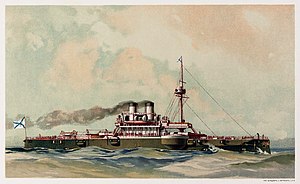 An 1892 lithograph depicting Chesma
| |
| History | |
|---|---|
| Name | Chesma |
| Namesake | Battle of Chesma |
| Builder | ROPiT Shipyard, Sevastopol |
| Cost | 3,217,500 rubles |
| Laid down | June 1883 |
| Launched | 18 May 1886 |
| In service | 29 May 1889 |
| Renamed | Stricken Vessel Nr. 4 22 April 1912 |
| Stricken | 14 August 1907 |
| Fate | Scrapped mid-1920s |
| General characteristics | |
| Class and type | Ekaterina II-class battleship |
| Displacement | 11,396 long tons (11,579 t) |
| Length | 339 ft 3 in (103.4 m) |
| Beam | 68 ft 11 in (21.0 m) |
| Draft | 28 ft 10 in (8.8 m) |
| Installed power | 9,059 ihp (6,755 kW) |
| Propulsion |
|
| Speed | 13.55 knots (25.09 km/h; 15.59 mph) |
| Range | 2,800 nmi (5,200 km; 3,200 mi) at 10 knots (19 km/h; 12 mph) |
| Complement | 633 |
| Armament |
|
| Armor |
|
Chesma (Russian: Чесма, also transliterated Tchésma) was the second ship of the Ekaterina II-class battleships built for the Imperial Russian Navy in the 1880s.[1] When the ship was completed she proved to be very overweight which meant that much of her waterline armor belt was submerged.[2] Russian companies could not produce the most advanced armour and machinery desired by the Naval General Staff, so they were imported from the United Kingdom and Belgium. Chesma spent her career as part of the Black Sea Fleet.
When the crew of the battleship Potemkin mutinied in June 1905,[a] the ship's crew was considered unreliable and she did not participate in the pursuit of the Potemkin. Chesma did, however, escort Potemkin as Sinop towed her back to Sevastopol from Constanța, Romania, where Potemkin had sought asylum. Chesma was turned over to the Sevastopol port authorities before being stricken on 14 August 1907. Before she was fully dismantled the Naval Ministry decided to use her hull for full-scale armour trials. She was re-designated as Stricken Vessel Nr. 4 on 22 April 1912 before being used as a gunnery target. Afterwards the ship served as a torpedo target for the destroyers of the Black Sea Fleet. During these attacks Chesma settled to the bottom of the Bay of Tendra and was eventually scrapped during the mid-1920s.
Cite error: There are <ref group=lower-alpha> tags or {{efn}} templates on this page, but the references will not show without a {{reflist|group=lower-alpha}} template or {{notelist}} template (see the help page).